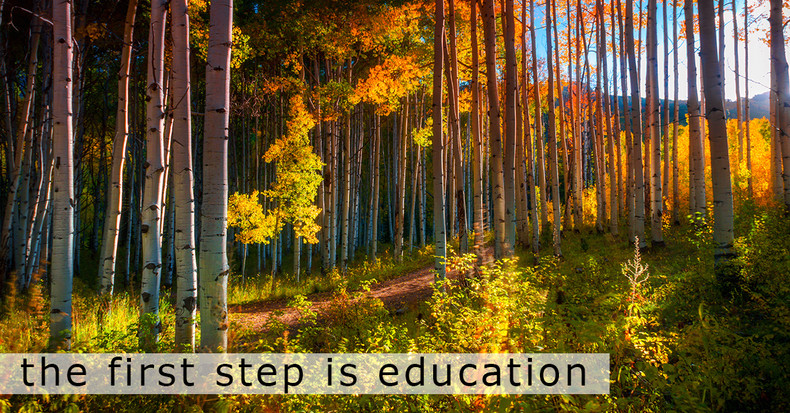
If you’re reading a blog on a grower’s supply site, there are many reasons you might have stopped by. Perhaps you’re a homeowner simply looking for garden hand tools. On the other hand, perhaps you manage a thousand acre orchard filled with citrus trees. Either way, you’re here because you have an interest in seeing plants grow. So when something threatens the growth of plants of any sort, it tends to interest people who read our blogs.
In previous blogs we’ve talked about troubles that have hit orchards. Today we’re going to talk about issues that threaten trees in wooded areas. Sometimes it’s disease, sometimes it’s insects, but all the time it’s worrisome to those who are care about the woodland environments. Of course, some of these problems are also hitting related trees in people’s yards. Let’s take a look at some problems that are affecting North American trees.
Aspen Cankers
Aspen trees are some of the most interesting trees on the planet. Unlike so many trees, they don’t grow from nuts or seeds. Instead they grow from an underground root system, kind of like asparagus! These groups of trees, called stands, live and die many times during the life cycle of the roots system. The roots can be some of the oldest living organisms in the world at more than 40,000 years old.
Still, above-ground pathogens can attack the “individual” trees. Aspens have very soft bark, so it’s more likely for the inside of the tree to become exposed and lead to fungal infestations. This leads to damage known as cankers, such as sooty-bark cankers and black cankers. There are also cankers named directly after the fungus itself, such as cryptosphaeria, cytospora canker, and hypoxylon.
The best way to treat infection is prevention. If possible, damage to any tree in the stand should be avoided. Because they share roots, damage to one tree can lead to the fungal destruction of many of them. So unless it’s necessary to remove one of your aspens, keep your garden tools away from them!
Comandra Blister Rust
Comandra blister rust affects hard pines. It’s a fungus that grows on the inner bark and causes infected trees to form stunted branches, often killing them and causing the tree to die back. These trees are often left with dead tops that look like they’ve been scorched by fire. This fungus affects not only living trees but also causes trees to form smaller pine cones with fewer seeds, meaning that it hurts the next generation of trees as well.
Comandra blister rust is especially disastrous to lodgepole and ponderosa pines and mostly affect pines in the western United States and western Canada. Interestingly, it has not been found in Northern Canada, Alaska, or Mexico, even though it’s found in New Mexico. Where does the name “comandra” come from? The fungus lives part of its life on a perennial herb called comandra. Without this herb nearby, it’s can’t complete its life cycle. Of course, this herb is almost always found close to pine trees.
Not much can be done in the wild to prevent comandra blister rust. Trees that are harvestable should be harvested as soon as the disease is noticed in order to prevent it from moving to other trees. If comandra blister rust affects a tree in your yard, removal of individual branches as they are infected can save the rest of the tree. Use a garden hand tools like a very sharp saw and wound paste so that the tree isn't damaged any more than it needs to be.
Dutch Elm Disease
Even if you don’t have an elm tree, it’s likely that you’ve heard of Dutch elm disease. This disease is spread by a fungus that causes the tree to attack itself.
Just as mosquitos are needed to transmit malaria among humans, the elm bark beetle is needed to transmit Dutch elm disease. The male beetles start eating at the bark, leaving the fungus behind in the process. Like an allergic reaction, the tree overreacts by plugging up its xylem tissues to isolate the fungus. But when it does this, the xylem is prevented from carrying water and nutrients up the trunk of the tree. When this happens, the tree dies.
The first sign of Dutch elm disease is when a tree’s leaves turn yellow and fall off months before the fall season comes around. The death of the tree continues further down the tree until it has no more leaves, at which time the roots die.
Once a tree is infected, it will almost certainly die. Worse yet, prevention is difficult. If the beetles are noticed on branches, the affected branches can be removed. However, the signs that beetles have been there (called “feeding galleries”) are often found in the main trunk of the tree. When the disease was first noticed a century ago, heavy insecticides were used to kill the beetle, but those poisons ended up killing many birds species, such as robins and woodpeckers, that were eating the beetle. There are antifungals that can be injected into the base of the tree which will protect them for two to three years. There is also a vaccine that arborists can give a tree that will help it fight the fungus. Unfortunately, both methods can be quite expensive. Still, if the trees are especially important, it can be worth it.
We want to do everything we can to help you help your trees, and the first step is education. Being aware of these tree maladies and what to watch for is the first step. And when you need to trim them to make them even healthier, check out our great selection of tree trimming equipment right here.

